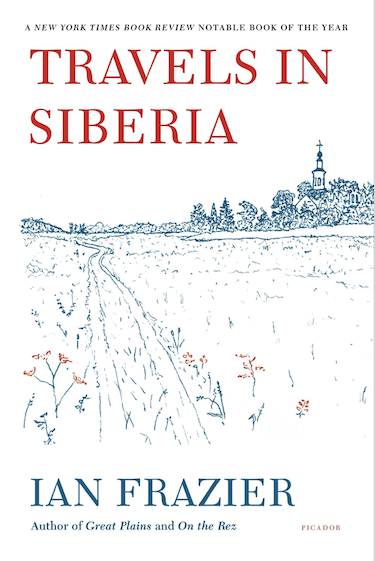Ian Frazier is a national treasure. He’s maybe best known as a longtime New Yorker columnist and features writer, covering pretty much anything that interests him, which is usually the outdoors. But his true genius is as a master of the darkly humored travelogue. His two most-read books are probably The Great Plains and On the Rez, each a wonderland of travel writing that hum with Frazier’s charming prose and his unmatched ability to wring beauty and life out of landscapes that don’t at first seem particularly exciting.
This talent practically oozes out of his best book, published in 2010, Travels in Siberia, a 500-page opus that winds its way through one of the world’s largest and most mysterious hunks of land.
Frazier traveled to Russia first in the 1990s, to Moscow mostly, but something drew his wandering eye eastward, toward that almost unimaginably vast land reaching from the Ural Mountains clear to the Pacific; a landmass large enough to fit the mainland U.S. and most of Europe too. He became obsessed with the strangeness of Russia, with the harsh climate, the unusual foods, the indomitable people, but mostly he was drawn to the sheer hugeness of Siberia, the Great Plains, more or less, of the east.
So he started making frequent trips to Siberia, poking his way in from Alaska, biting off chunks of territory at a time. Frazier even learned the Russian language. Still, he wanted more, so he decided to embark upon a grand voyage across the entirety of Siberia, by car, train, ferry, anything, really. He acquired a battered van, prepped it as best he could, enlisted the aid of two Russian guides, Sergei and Volodya, who swore they’d be able to repair the van during its unavoidable and surely numerous breakdowns. Once outfitted, Frazier set off into Siberia’s nearly inconceivable vastness and almost equally strange quirkiness.
Joining him along the adventure is an absolute joy.
Which is strange, actually, because almost nothing about Siberia comes across as appealing in the book. Sure, much of it is wild and untamed but also much of it is featureless swamp, impoverished villages, or crumbling cities. The weather seems always to be either bitterly cold, as you’d expect, or boiling hot, which you probably don’t. There are bugs too, lots of them, and they bite. There is uncomfortable camping, zillions of poorly timed breakdowns, a cast of characters too bizarre to list, and a sense of foreboding hanging over the entire book. As if at any point, Frazier’s small crew will encounter a Russian official who will throw them into one of the aging gulags they visit, or their van will explode, a drunken local will get a bit too friendly with an AK-47, or that they’ll simply succumb to the grey, endless tundra, which, despite a wealth of mining resources, often comes across as kind of a waste of space.
Here, Frazier explains:
As a landmass, Siberia got some bad breaks geographically. The main rivers of Siberia are (west to east) the Ob, the Yenisei, the Lena, and the Amur. I have seen each of these, and though the Mississippi may be mighty, they can make it look small…The problem with Siberia’s big rivers is the direction they flow. Most of Siberia’s rivers go north or join others that do, and their waters end up in the Arctic Ocean. Even the Amur, whose general inclination is to the northeast and whose destination is the Pacific, empties into the stormy Sea of Okhotsk. In the spring, north-flowing rivers thaw upstream while they’re still frozen at their mouths. This causes them to back up. This creates swamps. Western Siberia has the largest swamps in the world. In much of Siberia, the land doesn’t do much of anything besides gradually sag northward to the Arctic. The rivers of western Siberia flow so slowly that they hardly seem to move at all. There, the rivers run muddy; in eastern Siberia, with its real mountains and sharper drop to the Pacific, many of the rivers run clear.
Another bad geographic break is Siberia’s continentality. The land simply stretches on and on; eventually you feel you’re in the farthest, extra, out-of-sight section of the parking lot, where no one in the history of civilization has ever bothered to go. Only on the sea can you travel as far and still be in apparently the same place. The deeper into Siberia, the farther from the mitigating effect of temperate oceans, the harsher the climate’s extremes become. Summers in the middle of Siberia are hot, sometimes dry and dusty, sometimes hazy with smoke from taiga fires. In the winters, temperatures drop to the lowest on the planet outside Antarctica. In the city of Verkhoyansk, in northeast-central Siberia, the cold reaches about -90°. When I mentioned this frequently noted Siberian fact to my friends and guides in St. Petersburg, they scoffed, as Russians tend to do. Then they said they knew of someplace in Siberia even colder.
The more you read of Frazier’s travels in Siberia, the more the place begins to resemble a bizarro-world version of the American West. A place never fully tamed by the government forces cloistered away in decadent cities. Plains full of no-nonsense people who are fiercely proud of their self-sufficiency and gumption.
It’s difficult to sum up Frazier’s travelogue, not only because the book is more than 500 pages long, but because Frazier touches on everything. Russian history, politics, flora and fauna, culture, food, technology, humor, sport, environment—all of it. And every subject in his grand adventure gets Frazier’s one-two punch of subtle comic genius and lovesick melancholy-ridden ode to Siberia’s sheer oddity.
An adventure tale, a love letter, an eye-watering laugher, Travels in Siberia belongs in the pantheon of grand travelogues and is a winter must read.

